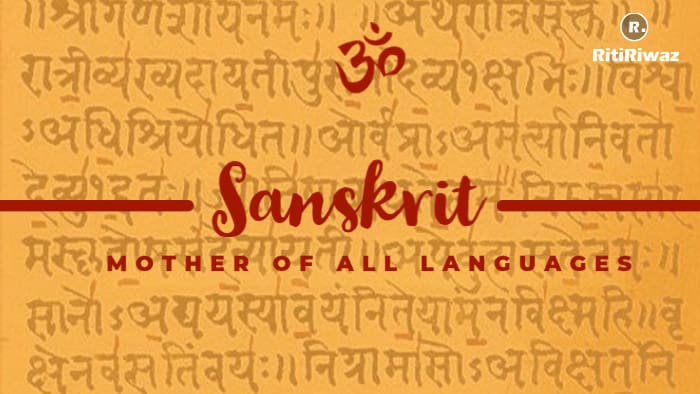Sanskrit – Mother of all Languages

Ever since human beings have invented scripts, writing has reflected the culture, lifestyle, society, and the polity of contemporary society. In the process, each culture evolved its own language and created a huge literary base. This literary base of civilization tells us about the evolution of each of its languages and culture through the span of centuries.
Sanskrit is the mother of many Indian languages. The Vedas, Upanishads, Puranas, and Dharmasutras are all written in Sanskrit. There is also a variety of secular and regional literature. By reading about the languages and literature created in the past, we shall be able to understand our civilization better and appreciate the diversity and richness of our culture. All this was possible because of the language that developed during that time.
Sanskrit, meaning cultured and refined, the classical language of ancient India, is one of the oldest and most systematic languages of the world. Many people think of Sanskrit in terms of Hindu religious literature because of the Veda Mantras and Slokas which are in use not only in India but throughout the Hindu diaspora in the world even today. It is one of the twenty-two languages listed in the Indian Constitution. The literature in Sanskrit is vast, beginning with the most ancient thought embodied in the Rig Veda, the oldest literary heritage of mankind. It was Sanskrit that gave impetus to the study of linguistics scientifically during the eighteenth century. The great grammarian Panini, analyzed Sanskrit and its word formation in his unrivaled descriptive grammar Ashtadhyayi.
The Buddhist Sanskrit literature includes the rich literature of the Mahayana school and the Hinayana school also. The most important work of the Hinayana school is the Mahavastu which is a storehouse of stories. While the Lalitavistara is the most sacred Mahayana text which supplied literary material for the Buddhacarita of Asvaghosa. Sanskrit is perhaps the only language that transcended the barriers of regions and boundaries. From the north to the south and the east to the west there is no part of India that has not contributed to or been affected by this language. Kalhan‘s Rajatarangini gives a detailed account of the kings of Kashmir whereas with Jonaraja we share the glory of Prithviraj. The writings of Kalidasa have added beauty to the storehouse of Sanskrit writings.
Suggested Read: World Sanskrit Day
The Vedas are the earliest known literature in India. The Vedas were written in Sanskrit and were handed down orally from one generation to the other. The preservation of the Vedas till today is one of our most remarkable achievements. There are four Vedas, namely, the- Rig Veda, Yajur Veda, Sama Veda, and Atharva Veda. Each Veda consists of the Brahmanas, the Upanishads, and the Aranyakas.
The word Upanishad is interpreted variously. It is made to correspond with the word updsana which is understood to mean either worship or profound knowledge. The Upanisads are also called the Vedanta because they represent the concluding portion of the apauruseya Veda or Sruti, or the final stage in Vedic instruction, or the ultimate end and aim of the teachings of the Veda. Vedangas, present an attempt to systematize various aspects of that knowledge which are necessary for understanding the Vedic texts.
The Ramayana and the Mahabharata represent the ethos of ancient India. Tradition places the Ramayana earlier than the Mahabharata. The nucleus of the Mahabharata may have been older than that of the Ramayana, but in their present forms, the Ramayana appears to be the earlier work.
The Puranas are a very important branch, of the Hindu sacred literature. They enable us to know the true import of the ethos, philosophy, and religion of the Vedas. They clothe with flesh and blood the bony framework of the Dharma-Sutras and the Dharma-Sastras. The Puranas relate to the whole of India so far as the historical portion therein is concerned and to the whole world so far as their ethical, philosophical, and religious portions are concerned.
Suggested Read: Quotes on Sanskrit Language
We also have a large body of books dealing with various sciences, law, medicine, and grammar. Kautilya‘s Arthashastra is an important treatise of the Mauryan times. It reflects the state of society and economy at that time and provides rich material for the study of ancient Indian polity and economy.
The works of Bhasa, Shudraka, Kalidasa, and Banabhatta provided us with glimpses of the social and cultural life of northern and central India in times of the Guptas and Harsha. The Gupta period also saw the development of Sanskrit grammar based on the works of Panini and Patanjali.
Jawaharlal Nehru, the late prime minister of India, wrote in “Discovery of India“: “If I was asked what is the greatest treasure which India possesses and what is her greatest heritage, I would answer unhesitatingly that it is the Sanskrit language and literature and all that it contains. This is a magnificent inheritance, and so long as this endures and influences the life of our people, so long will the basic genius of India continue.”
